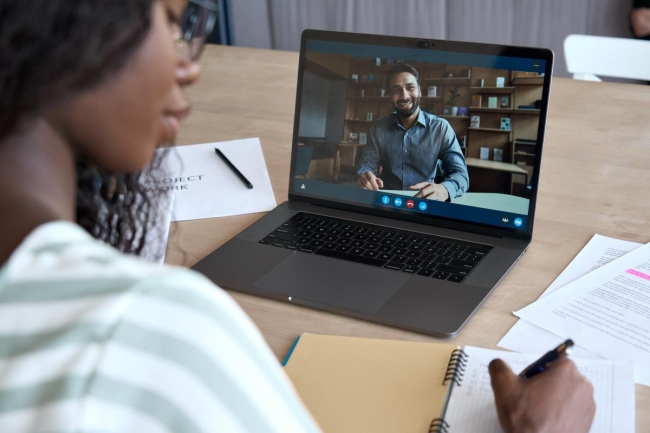You have /5 articles left.
Sign up for a free account or log in.

Online classes are becoming more popular for law students in the wake of the pandemic.
insta_photos/Getty images
When the history of the COVID-19 pandemic is written, one takeaway may be that the crisis marked a positive turning point in which online learning in higher education gained more respect. To be sure, in the early days of the pandemic, few were satisfied with emergency remote instruction, even if teachers displayed “heroic levels of creativity” in the face of a global emergency. But as waves of the virus ebbed and flowed over time and one variant replaced another, faculty members adapted remote learning best practices into their courses. Many students subsequently discovered unexpected benefits in online learning, often leaving them asking for more.
Law students’ perceptions of the gap between online and in-person instruction has narrowed considerably since the start of the pandemic, according to a recent Gallup-AccessLex report. In 2021, approximately three-quarters (76 percent) of law students taking classes mostly or fully in person rated their programs as “excellent” or “good,” whereas only about half (51 percent) taking at least half of their classes online reported the same. Face-to-face student perceptions mostly held steady in 2022, when again approximately three-quarters (78 percent) rated their programs as “excellent” or “good.” But their hybrid and online counterparts made significant gains in 2022; 73 percent of hybrid students and 72 percent of those who were mostly or completely online held those same favorable opinions of their programs.
Online law school is a relatively new phenomenon. Prior to the pandemic, fewer than 10 law schools offered hybrid J.D. programs, according to the report. Back then, law schools accredited by the American Bar Association were only allowed to offer one-third of their credits via distance education. But once COVID-19 turned into a pandemic, the ABA offered temporary permission for then-in-person law schools to offer their programs online—and most followed suit.
In 2021, most students had an unfavorable view of that initial experience transitioning to online learning, according to the report.
“It wasn’t what they signed up for, the sudden loss of in-person contact with their professors and peers was acutely felt, and school administrators and faculty had to adjust to a distance-learning format on the fly,” the report’s authors wrote.
But time heals some wounds, especially when faculty members stepped up to gain proficiency in online teaching best practices. Also, students discovered some advantages to hybrid and online learning, including the flexibility the formats offer.
Approximately half of students (51 percent) in mostly or completely face-to-face programs agreed in 2021 that their professors were using teaching methods that engaged them. Smaller percentages of hybrid students (45 percent) and mostly or completely online students (48 percent) felt the same. In 2022, those percentages ticked up to 60, 57 and 56 percent respectively, suggesting that students now perceive a narrower gap between online, hybrid and in-person learning.
Despite the gains in online course delivery, students still perceive some differences. For example, even in 2022, a majority (63 percent) of students reported feeling “emotionally drained” after online classes as opposed to just under half (48 percent) of in-person students who felt the same. Perhaps for this reason, some faculty members have championed hybrid formats in which they seek to maximize the benefits of each format.
“Every day of a law student’s life requires acts of triage … because there’s always too much work,” Brian Larson, a Texas A&M law professor, said. “If you allow students to make your class the one they can put off till tomorrow, they’re going to put it off till tomorrow.”
For this reason, Larson uses online learning management system tools, including forums and options for peer review feedback, even when he teaches face-to-face. He structures his courses with intermediate deliverables by doing so.
“If you structure it so that they can’t [put off work], they won’t, because they’re damn smart,” he said.
Many students and faculty members also have a newfound appreciation for the flexibility and access that online and hybrid options offer.
“Three or four years ago, we used to talk about remote learning as a last resort—something that students would only be willing to do if they, for example, lived in a rural area or had a job that absolutely prevented them from participating in regular synchronous law school classes,” said Tom Cobb, a law professor at Mitchell Hamline School of Law, an early pioneer of blended legal education. (Cobb’s students have long had the option of spending a few weeks per year on campus and otherwise studying at a distance.) “Post-pandemic, it’s becoming more and more normal for students to participate in remote law classes, even if they’re not in a situation that requires it.”
Indeed, online options make dreams of law degrees more accessible. Russell Osgood, a law professor and dean of the Washington University School of Law, welcomes the flexibility that hybrid options afford his students, especially for those who are parents, manage illnesses or have other family responsibilities.
“Honestly, most of [the parents] are moms,” Osgood said. “I’d see the kid crawl by, and I’d turn the kids into celebrities,” he said about his parent students who attend his in-person classes via Zoom. “That’s good, and I don’t think it’s ever going to change.”
Osgood noted that a fully online legal studies program launched at his institution just before the pandemic has had a much greater demand than the school had anticipated.
“The pandemic no doubt encouraged people to pursue it,” he said.
Other law school leaders saw similar trends.
“Working students benefit hugely from not having to spend 45 minutes traveling to and from the law school every day,” said Matthew Diller, dean of the Fordham Law School. “Mixing online classes in with in-person classes, particularly for working students, makes a ton of sense.”
In some cases, the option to teach online at least some of the time offers advantages not only for student flexibility but for delivery of educational content.
“When you want to project a student’s text on the screen and talk through it with the class, that’s actually easier to do with an online class than it is in a classroom where students are having a hard time reading it on the screen at the front of the room,” Larson said. “And you can’t send them off to talk about it as easily as you can in a Zoom classroom.”
Still, faculty members and administrators still have some bugs to fix in hybrid instruction.
“All of us are going to have to rewire our classrooms so we can pick up the voices of people asking questions” who are attending via Zoom, Osgood said. “Ironically, if you do not have that technology, the only student voice that they can hear really well [in the classroom] is the person who is online, because she’s talking into a microphone and her picture is shown.”




